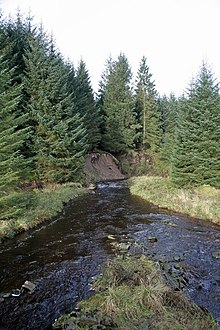River Lyne

The River Lyne is a river of Cumbria in England.
The river is formed near the hamlet of Stapleton, five miles west of Bewcastle, by the confluence of the Black Lyne (moving from the north) and the White Lyne (from northeast).[1]
Both branches have sources in the remote north east of Cumbria in Kershope Forest[2] close to the borders with Scotland and Northumberland, with the Black Lyne having its source at Blacklyne Common and the White Lyne at Whitelyne Common.
After the meeting of the waters, the river continues in a west-by-south-westerly direction to Lynefoot, where it flows into the Border Esk.
Alternative etymologies includes Llyn (^circumflex over y) which can look like Lyn but pronounced “Lainn” or “leen” meaning in Scots Gaelic Laighin or Lainn “a spear or blade”. Ll^yn/Lleyn/Lainn is the Cumbric Welsh spelling of Laighin or Lainn similar to the Ll^yn Peninsula Llŷn Peninsula in North Wales in the old kingdom of Gwynedd. The Ui Laighin settled there. But the Ui Laighin were also Brigantes Celts the Uí Bairrche in both Leinster and North Britain up to and slightly beyond Hadrians Wall and Ptolemy’s map identify the Brigantes Celts in both areas of the British Isles. These Brigantes were also Laighin (pronounced “Lainn”) and took surname forms later of Laing, Layng, Lainn, Lyne, Lynes, Lyons, Lane, Leyne, Leing, Leen, etc. The River White Lyne and Black Lyne in Cumbria East of Carlisle and West of Bewcastle and Lynes hamlet near Bewcastle to the SW also has the same Laighin/Ll^yn/Leyne/Lainn etymology although these rivers were also called Leven/Levan from Gaelic “Liamhain” meaning Elm/Scots Elm tree. Ancient the area was called Leven but both etymologies are possible and fit with the existence of both Gaelic and Cumbric Welsh spoken in these regions anciently especially with the Brigantes Celts who also were called Galeion or Coriondi or Laighin in both regions. Additionally the Ui Dunlaing were a leading king kindred of Leinster or Ui Laighin and is another similar origin as Laing and Lainn meaning “spear or blade” which was their tribal kindred name. The Corionototae were noted on a Roman inscription near Hadrians Wall as well which is similar to Coriondi in Leinster Ireland. Anciently people called things by sound and descriptive meaning of the names of regions, peoples, rivers, hills, place names, etc
See Lyne, Scottish Borders See Lyne Water
[2]
References
- ^ Rand McNally Encyclopedia of World Rivers. Rand McNally and Company. 1980. p. 249.
- ^ a b John Morris; Richard White (1995). Arthurian Sources: Places and peoples, and Saxon archaeology.
54°58′41″N 3°00′10″W / 54.9780°N 3.0029°W / 54.9780; -3.0029
- v
- t
- e
This article related to a river in England is a stub. You can help Wikipedia by expanding it. |
- v
- t
- e










